
ISSN: 2321-9653; IC Value: 45.98; SJ Impact Factor: 7.538
Volume 10 Issue XII Dec 2022- Available at www.ijraset.com


ISSN: 2321-9653; IC Value: 45.98; SJ Impact Factor: 7.538
Volume 10 Issue XII Dec 2022- Available at www.ijraset.com
Associate Professor, Department of Chemistry, DBS (PG) College, Dehradun - 248001, India.

Abstract: Leaf extract of green inhibitor (commonly known as Borrachero or Morning Glory) is found to be efficacious on corrosion of mild steel in mixed acid solution in paste form using traditional weight loss measurements techniques. For different solution concentrations in the form of paste at various temperatures, corrosion inhibition efficiency of Borrachero leaf extracts was assessed with the help of weight loss measurements. For comparison, date of rust dissolution in liquid state has also been furnished. Different temperature conditions were appraised for the sake of overall inhibitor efficiency. From the results, Borrachero leaves have a good potential, at certain range of temperature, as eco-friendly, green, corrosion inhibitor.
Keywords: Mild steel, corrosion, inhibitor, dissolution, Borrachero leaf.
Corrosion is a natural process that converts a sifted metal into a more chemically stable oxide. It is the gradual degradation of materials (usually a metal) by chemical or electrochemical reaction with the environment. Corrosion deteriorates the useful properties of materials and structures including strength, appearance and permeability to liquids and gases. The hydrogen molecule, due to slow rate of formation in some cases, penetrates the crystal lattice and deforms it leading to brittleness of metal. Organic, inorganic, or a mixture of both inhibitors can inhibit corrosion by either chemisorption on the metal surface or reacting with metal ions and forming a barrier-type precipitate on its surface [1].
Because of the noxious nature and/or high cost of some chemicals currently in use as inhibitors, there is a need to develop environmentally acceptable and pocket - friendly ones. Natural products can be considered as a good source for this purpose. The aqueous extracts from different parts of some plants such as Pennyroyal oil from Mentha pulegium [2], Jojoba oil [3], Artemisia oil from Artemisia herba alba [4], [5], Natural oil from Cassia auriculata, Cassia siamea gonrai, Strychnos nuxvomica and Crataeva religiaso [6], Rosemary oil [7, 8], Oil from Eucalyptus [9]. the essential oils from various plants such Lavender [10], Foeniculum Vulgare [11], Pulicaria mauritanica [12], Prickly pear seed [13], Chamomile oil from Chamomilla recutita [14], Exyngium maritimum [15], Verbena [16, 17] are having a reasonable corrosion inhibition on metals in aggressive media. In the present work our aim is to use inhibited pickling acid in the paste form so that it can be conveniently applied on large structures as well as on small tools to be pickled / cleaned. As a contribution to the current interest on environment friendly, green, corrosion inhibitors, the present study investigates the inhibiting effect of Borrachero leaves, a green inhibitor which is also known as Morning Glory. It is a robust, fast-growing, erect shrub or climber and is quite easily available in India

Mild steel (Fe 99.30%, C 0.076%, Si 0.026%, Mn 0.192%, P 0.012%, Cr 0.050%, Ni 0.050%, Al 0.023%, and Cu 0.135%) panels of size 10 cm * 7.5 cm of pickled cold rolled closed annealed mild steel (18 SWG) cut from a single sheet were used in all experiments. For identification of specimens all were numbered and a suspension hole of about 2 mm diameter near upper edge was made. The specimens were polished to mirror finish with emery paper. They were cleaned with cotton to remove powder and traces of adhered metal, and then they were degreased with sulphur – free toluene followed by cleaning with methanol before experiments. All the acid and chemicals used in the experiment were of AR grade quality. Distilled water was used for the preparation of solution. In the study, 4N solutions of acids were prepared.
Clay – soil was collected, washed, dried, powdered and sieved. 100 gm sieved soil was taken in a plastic glass with a hole at the bottom. This glass was put over uninhibited and inhibited acids. Soil-soaked acid uniformly and thus pickling paste was prepared. 100 gm soil soaked 31.3 cc acid.
ISSN: 2321-9653; IC Value: 45.98; SJ Impact Factor: 7.538 Volume 10 Issue XII Dec 2022- Available at www.ijraset.com

Polished and weighed panels were suspended by a V-shaped hook made of capillary over 100 % humidity for 6 months at room temperature. In 6 months, heavy rust appeared on the panels. Panels were re-weighed to get the amount of rust.
Pickling paste was applied over weighed rusted panels under different conditions. After the experiment, paste was removed by washing with saturated sodium bicarbonate solution. The panels were again washed with water and dried with hot air. The panels were finally weighed to get the amount of rust dissolved. Experiments were conducted in triplicate and mean value is reported in the Table.
The Borrachero leaves were dried, crushed, and powdered. This powder thus obtained was used as inhibitor. 1 mg of it was added to 100 cc of acid and kept for 24 hours. This acid was used for the preparation of inhibited pickling paste. The inhibitor efficiency was calculated from the following equation:

%IE = Wuninhibited – W iinhibited * 100 Wuninhibited
Where,
%IE = Inhibitor efficiency
Wuninhibited = Wt. loss without inhibitor W inhibited = Wt. loss with inhibitor
Table 1 and 2 and figure 1a and 2[a, b and c] show the effect of temperature (30°C-60°C) on attack of mild steel due to paste containing 40 HCl (4N) + 60 H2SO4 (4N) with and without 1.0% inhibitor. In uninhibited paste, the weight loss of mild steel specimens varied from 19.7 mg/dm2/hr to 44 1 mg/dm2/hr in a temperature range of 30°C to 60°C. In inhibited paste, the weight loss varied from 7 0 mg/dm2/hr to 14 9 mg/dm2/hr respectively at the same temperature range. The inhibitor efficiency varied from 64% at 30°C to 66% at 60°C. Arrhenius plots have been drawn showing the dependence of log corrosion rate on 1/T for uninhibited paste and inhibited paste. The linear nature of both the curves indicates that they obey the Arrhenius Equation.
Table 1: Effect of temperature on the rate of dissolution of rust and on the rate of attack of mild steel [40 HCl (4N) + 60 H2SO4 (4N); 1 hr.; 3.0 gm paste/dm2 = coating thickness]
Temperature (°C)
Weight Loss (mg/dm2/hr) Paste State Liquid State 30 1.4 19.7 185 35 1.6 21.2 189 40 1.9 26.1 197 45 2.3 31.3 201 50 2.8 35.6 207 55 3.3 39.4 213 60 3.7 44.1 218
Rate of Dissolution of Rust (gm/dm2/10min)
ISSN: 2321-9653; IC Value: 45.98; SJ Impact Factor: 7.538 Volume 10 Issue XII Dec 2022- Available at www.ijraset.com

Figure 1: Effect of temperature on the rate of dissolution of rust and on the rate of attack of mild steel [40 HCl (4N) + 60 H2SO4 (4N); 1 hr.; 3.0 gm paste/dm2 = coating thickness(for paste state)]
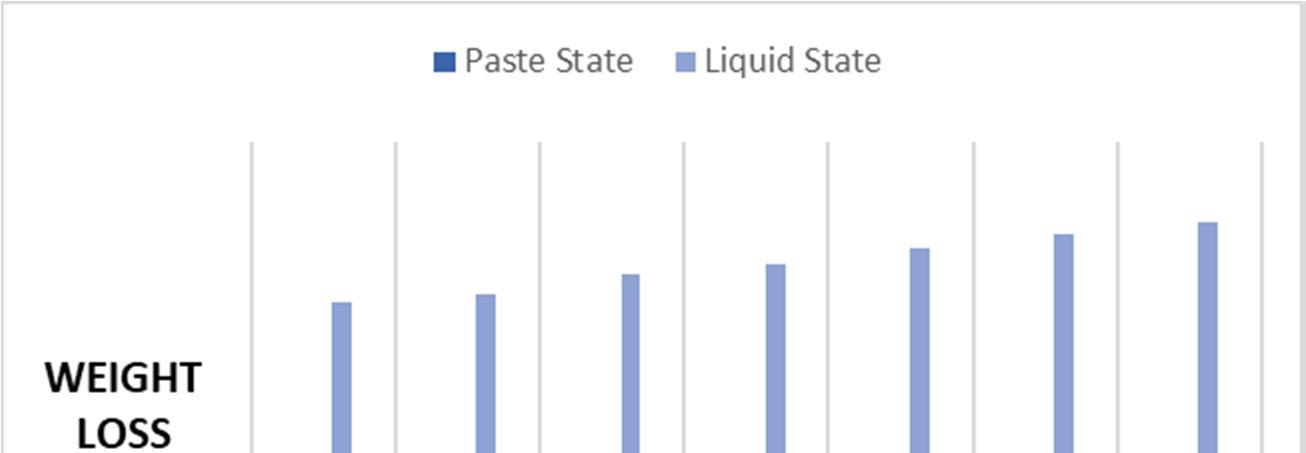
Table 2 : Effect of temperature on the rate of dissolution of rust and on the rate of attack of mild steel [40 HCl (4N) + 60 H2SO4 (4N); 1 hr.; 3.0 gm paste/dm2 = coating thickness] {also shows the values of 1/T and log weight loss to obtain Arrhenius plot}
Weight loss (mg/dm2)
Temperature (°C) 1/T * 104
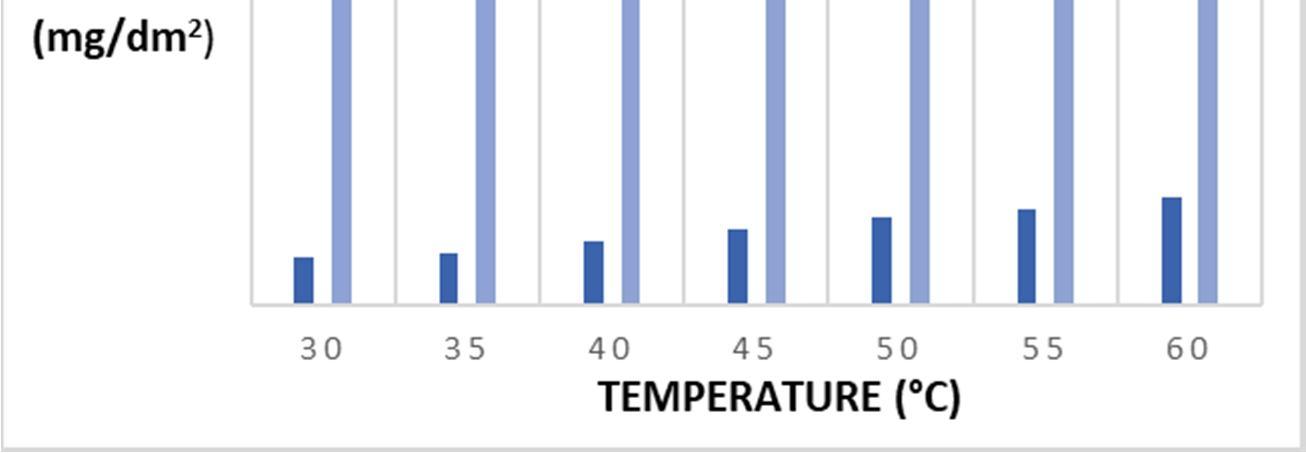

Inhibitor Efficiency (%IE)
Un. log Weight loss In. log Weight loss 30 33 19.7 1.2945 7 0.8451 64 35 32.4 21.2 1.3263 7.8 0.8921 63 40 31.9 26.1 1.4166 9.6 0.9823 63 45 31.4 31.3 1.4955 10.9 1.0374 65 50 30.9 35.6 1.5514 12.8 1.1072 64 55 30.4 39.4 1.5955 13.7 1.1367 65 60 30 44.1 1.6444 14.9 1.1732 66

ISSN: 2321-9653; IC Value: 45.98; SJ Impact Factor: 7.538 Volume 10 Issue XII Dec 2022- Available at www.ijraset.com
Figure 2a : Effect of Temperature on the rate of attack of mild steel [40 HCl (4N) + 60 H2SO4 (4N); 1 hr.; 3.0 gm paste/dm2 = coating thickness; inhibitor = 1%][Arrhenius Plot]

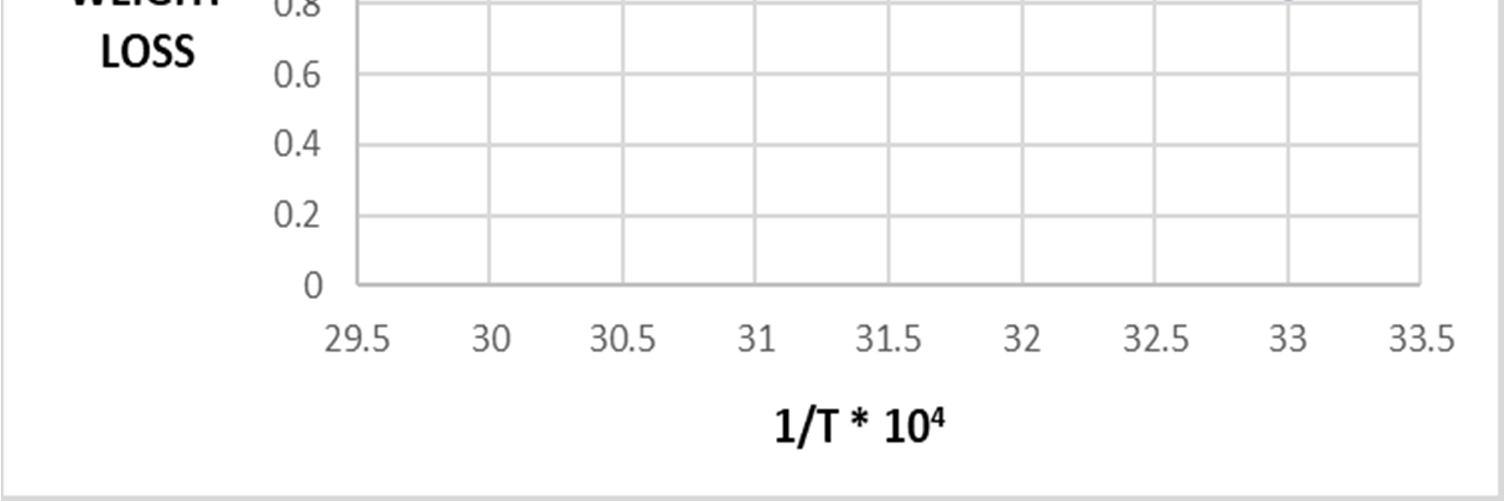
The activation energies calculated from the slopes of the two curves gave values 5.43 Kcal/mol for uninhibited paste and 5.08 Kcal/mol for inhibited paste. The presence of inhibitor lowers the activation energy and rate of the reaction which appears to be contradictory as for most of the inhibitors, the values of activation energy remain unchanged. This is attributed to increased coverage of metal surface with inhibitor at higher temperature and also because the chemisorbed passive film is produced faster than its dissolution at higher temperature.


Figure 2b : Figure 2a : Effect of Temperature on the rate of dissolution of rust [40 HCl (4N) + 60 H2SO4 (4N); 1 hr.; 3.0 gm paste/dm2 = coating thickness; inhibitor = 1%]

ISSN: 2321-9653; IC Value: 45.98; SJ Impact Factor: 7.538 Volume 10 Issue XII Dec 2022- Available at www.ijraset.com
Figure 2c: Effect of Temperature on the inhibitive performance of Borrachero leaf extract [40 HCl (4N) + 60 H2SO4 (4N); 1 hr.; 3.0 gm paste/dm2 = coating thickness; inhibitor = 1%]


The efficiency of the inhibitor improved with the temperature, corresponding to the chemisorption of the inhibitor on the electrode. The adsorption of inhibitor extract is uniform over the surface. The inhibition is due to the formation of the film on the metal/mixed acid solution interface through adsorption of inhibitor extract molecules. Chromatographic separation of the extract resulted in the isolation of following alkaloids:
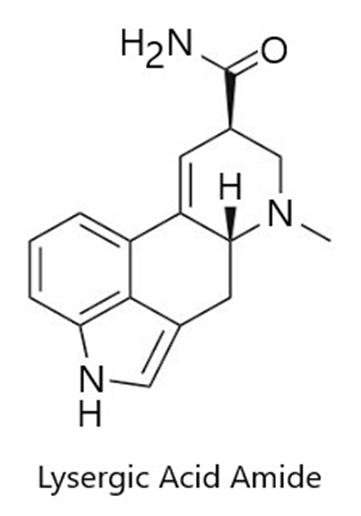

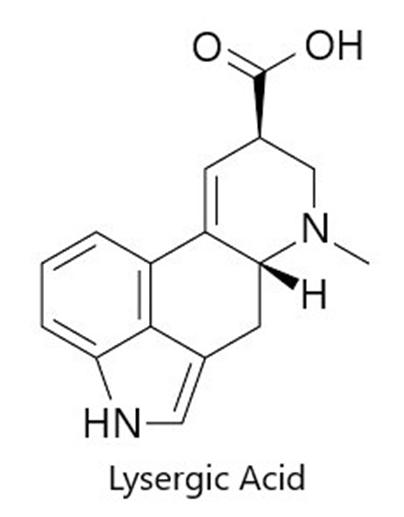

The author declared no potential conflicts of interest with respect to the research, authorship, and/or publication of this article.

The author received no financial support for the research, authorship, and/or publication of this article.
I am grateful to DBS(PG)College for letting me use their resources for the conduct of the experiments. I am also thankful to the editor and anonymous reviewers who helped with the current shape of the paper by their constructive and insightful comments and suggestions.

[1] K. Srivastava and P. Srivastava, British Corrosion Journal,16(4),pp.221,1981.
[2] B. Bouyanzer, B. Hammouti and L. Majadi, Mater. Lett., 60, 2840(2006), DOI: 10.1016/j.matlet.2006.01.103.
[3] A. Chetouani, B. Hammouti and M. Benkaddour, Pigm. Res. Techn., 33, 26(2004), DOI: 10.1108/03699420410512077.

ISSN: 2321-9653; IC Value: 45.98; SJ Impact Factor: 7.538 Volume 10 Issue XII Dec 2022- Available at www.ijraset.com
[4] A. Bouyanzer and B. Hammouti, Pigm. Res. Techn., 33, 287(2004), DOI:10.1108/03699420410560489.
[5] M. Benabdellah, B. Hammouti, M. Bendahhou and A. Aouniti, Appl. Surf. Sci., 252, 6212(2006), DOI: 10.1016/j.apsusc.2005.08.030.
[6] N. Poongothai, N. Rajendran and M. Palaniswamy, Indian J. Chem. Tech., 12, 641(2005), DOI: 10.1016/j.nopr.niscair.2005.123456789/8684.
[7] E. Chaieb, A. Bouyanzer, B. Hammouti, M. Benkaddour and M. Berrabah, Trans. SAEST., 39, 58, (2004).
[8] M. Bendahou, M. Benabdallah and B. Hammouti, Pigm. Res. Techn., 35, 95(2006), DOI: 10.1108/03699420610652386.
[9] A. Bouyanzer, L. Majidi and B. Hammouti, Bull. Electrochem., 22, 321 (2006).

[10] O.Ouachikh, A. Bouyanzer, M. Bouklah, J-M. Desjobert, J. Costa, B. Hammouti and L. Majidi, Surf. Rev. Lett., 16, 49(2009), DOI: 10.1142/S0218625X09012287.
[11] B. Zerga, M. Sfaira, Z. Rais, M. Ebn Touhami, M.Taleb, B. Hammouti, B. Imelouane and A. Elbachiri, Materiaux et Technique, 97, 297(2009), DOI: 10.1051/mattech/2009045.
[12] N. Lahhit, A. Bouyanzer, J.M. Desjobert, B. Hammouti, R. Salghi, J. Costa, C. Jama, F. Bentiss and L.Majidi, Portugal. Electrochimi. Acta., 29, 57(2011), DOI: 10.4152 / pea.201102127.
[13] M. Znini, G. Cristofari, L. Majidi, A. Bouyanzer, J. Paolini , B. Hammouti and J. Costa, Int. J. Electrochem. Sci., 6, 6699(2011)
[14] D. Ben Hmamou, R. Salghi, Lh. Bazzi, B. Hammouti, S.S. Al-Deyab, L. Bammou, L. Bazzi and A. Bouyanzer, Int. J. Electrochem. Sci., 7, 1303(2012), DOI: 10.1186/2228-5547-3-25
[15] D. Ben Hmamou, R. Salghi, A. Zarrouk, B. Hammouti, S.S. Al-Deyab, Lh. Bazzi, H. Zarrok, A. Chakir and L. Bammou, Int. J. Electrochem.Sci., 7, 2361 (2012).
[16] F. Darriet, M. Znini, L. Majidi, A. Muselli, B. Hammouti and A. Bouyanzer, J. Costa, Int. J. Electrochem. Sci., 8, 4328(2013).
[17] D. Ben Hmamou, R. Salghi, A. Zarrouk, H. Zarrok, M. Errami, B. Hammouti, L. Afia, Lh. Bazzi and L. Bazzi, Res. Chem. Intermed., 39, 973(2013). *****
